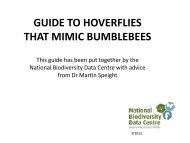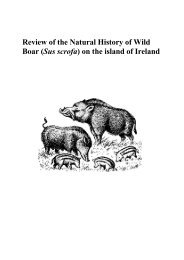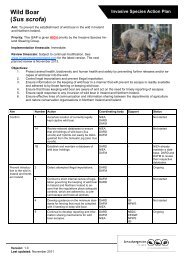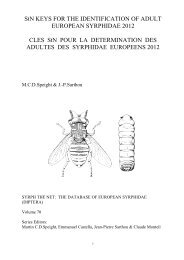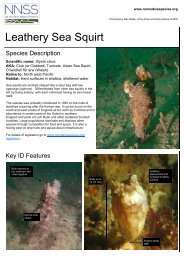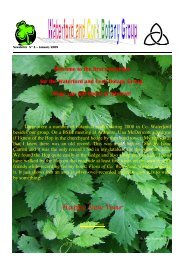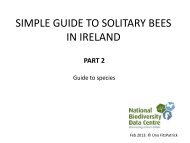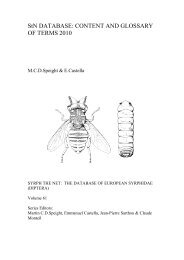Create successful ePaper yourself
Turn your PDF publications into a flip-book with our unique Google optimized e-Paper software.
www.nonnativespecies.org<br />
Produced by Olaf Booy, Max Wade and Vicky White of RPS<br />
<strong>Japanese</strong> <strong>Knotweed</strong><br />
Species Description<br />
Scientific name: Fallopia japonica<br />
AKA: <strong>Japanese</strong> Bamboo, Pysen saethwr (Welsh),<br />
Polygonum cuspidatum, Reynoutria japonica<br />
Native to: Japan, Taiwan, northern China<br />
Habitat: Common in urban areas, particularly on waste<br />
land, railways, road sides and river banks<br />
Tall herbaceous perennial with bamboo like stems. Often grows into dense thickets.<br />
Characteristic leaves and stems, persistence of last year’s dead canes and distinctive<br />
rhizome (underground root-like stems) enables year round identification.<br />
Introduced in the early 19 th century as an ornamental plant. Now common and widespread<br />
across the UK. Spreads rapidly in the wild by natural means and as a result of<br />
spread by humans. Spread is solely by vegetative means, either fragments of rhizome or<br />
stem. Does not produce seed in the UK. Negative impacts include outcompeting native<br />
flora, contributing to river bank erosion and increasing the likelihood of flooding. Can<br />
also cause significant delays and cost to development as well as structural damage (it<br />
can grow through asphalt and some other surfaces).<br />
<strong>Japanese</strong> <strong>Knotweed</strong> is listed under Schedule 9 to the Wildlife and Countryside Act 1981<br />
with respect to England, Wales and Scotland. As such it is an offence to plant of otherwise<br />
cause <strong>Japanese</strong> knotweed to grow in the wild. Under the Environmental Protection<br />
Act 1990, <strong>Japanese</strong> <strong>Knotweed</strong> is classified as controlled waste.<br />
For details of legislation relating to non-native species please see:<br />
http://www.nonnativespecies.org/07_Legislation.cfm<br />
Key ID Features<br />
Shield shaped<br />
leaves<br />
Zig-zag<br />
stems<br />
Purple<br />
speckled<br />
stems<br />
Regular<br />
nodes (like<br />
bamboo)<br />
Flat base<br />
Rhizome crown at<br />
base of plant<br />
Rhizome<br />
White<br />
shoots<br />
Cross-section<br />
Lush green<br />
colour<br />
Bright orange inside
Identification<br />
throughout the year<br />
Summer<br />
Winter<br />
Spring<br />
Flowers in summer<br />
Similar Species<br />
up to 40cm<br />
Lobed<br />
base<br />
The species most likely to be confused with<br />
<strong>Japanese</strong> knotweed are those with which it is<br />
closely related: giant knotweed and its hybrid.<br />
Both are relatively uncommon in the UK. Key<br />
differences between these are given below.<br />
Much larger<br />
leaf<br />
10-15cm<br />
Smaller<br />
leaf<br />
Flat<br />
base<br />
<strong>Japanese</strong><br />
<strong>Knotweed</strong><br />
For comparison<br />
Distribution<br />
Widespread and common across the UK. Notably<br />
extensive infestations are found in the south-west<br />
of England, south Wales and Greater London,<br />
however similarly extensive populations can also<br />
be found elsewhere.<br />
Source: NBN Gateway. Check website<br />
for current distribution<br />
Giant <strong>Knotweed</strong><br />
Non-native<br />
(Fallopia sachalinesis)<br />
Source: Child and Wade<br />
(2000). The <strong>Japanese</strong><br />
<strong>Knotweed</strong> Manual<br />
up to 23cm<br />
Hybrid<br />
Non-native<br />
(Fallopia x bohemica)<br />
Intermediate<br />
size and shape<br />
References and further reading:<br />
Blamey, M, Fitter, R and Fitter, A (2003) “The<br />
Wild Flowers of Britain and Ireland. The Complete<br />
Guide to the British and Irish Flora.” A & C<br />
Black<br />
Child, L E and Wade, P M (2000) “The <strong>Japanese</strong><br />
<strong>Knotweed</strong> Manual”. Packard<br />
Environment Agency (2006) “The <strong>Japanese</strong><br />
<strong>Knotweed</strong> Code of Practice”. Environment<br />
Agency<br />
Preston, C D, Pearman, D A and Dines, T A<br />
(editors) (2002) “New Atlas of the British and Irish<br />
Flora”. Oxford University Press<br />
Stace, C (1999) “Field Flora of the British Isles”.<br />
Cambridge University Press<br />
Photos from: Olaf Booy, Helen Parish, Max Wade, Vicky White



